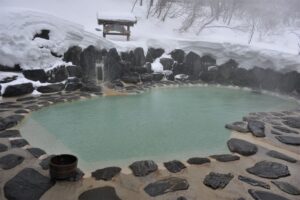
Matsukawa Onsen is blessed with cloudy, blue-hued water, a sign of a high mineral content in the hot spring. Water source temperatures range from 54 C to 65 C, providing naturally heated warm baths year-round. Set in a picturesque mountain valley, Matsukawa Onsen features views from every vantage point of the stunning beauty of Mother Nature, especially when soaking in one of the six outdoor baths at the three inns there.
Lead photo: The mixed-bathing outdoor bath at Kyounso inn at Matsukawa Onsen in Iwate Prefecture
Hot Spring Review: Matsukawa Onsen
Basics
- Hot spring name: Matsukawa Onsen (JP: 松川温泉)
- Source water temp: 54 C – 65 C*
- Hot spring type: Sulfur hot spring*
- Inns: 3: Shofuso inn, Kyounso inn, Matsukawaso inn
- Prefecture: Iwate
- *Learn more about this information
Water
Matsukawa Onsen’s water is superb. No additional heating is necessary because water comes from multiple sources at temperatures ranging from 54 C to 65 C. The flow rate is sufficiently plentiful that the inns do not recirculate the water, meaning the bathwater is constantly 100% hot spring water.
The source of the springs is located about 5 meters underground.

The hot spring is a sulfur spring, meaning the scent of rotten eggs is in the air – a mark of quality in the onsen world. Additionally, the water has a bluish tint, reflecting a high mineral content – another sign of quality.
Location
Matsukawa Onsen is located in a valley in the mountains of northwestern Iwate Prefecture in Towada-Hachimantai National Park and with, in some places, views of Mt. Iwate, the tallest peak in the prefecture. Even with winter’s heavy snowfall all three inns are open year-round.

Access
Matsukawa Onsen is a two-leg, 110-minute bus ride from central Morioka, the capital of Iwate Prefecture. Morioka Station is on the Tohoku Shinkansen Line with direct access from Tokyo Station in two hours and 15 minutes at the fastest.
Admittedly, it’s not close. But isn’t that part of the point?
Onsen Adventures’ advice is to stay at two inns and visit a third for the baths only. All three are located within easy walking distance.
Bonus points
The first point is that the second leg of the bus ride is done via a 1968 Subaru bonnet bus, adding a classic element to the trip as it literally and figuratively transports visitors to another world.
A 1968 Subaru bonnet bus ferries visitors to Matsukawa Onsen along the second leg of the trip from Morioka.

Secondly, Tohoku Electric operates a geothermal power plant at Matsukawa Onsen. There are 11 bores that go down 1,000 to 1,600 meters to catch hot water and steam, which are then used to turn turbines and generate electricity. The electricity is fed into the main power grid.
Matsukawa Onsen provides an excellent example of the peaceful coexistence of onsen establishments and a geothermal power plant.
The power station pipes leftover steam to all three inns, which is used for heating. This not only saves a lot of money, but ensures the inns are warm, if not downright hot. This is a rarity at cold-weather ryokan in Japan. Because the heat is generated from steam, it cannot be regulated, only turned on and off. Thus, the answer to “what to do if it is too hot” is “open the window.” Temperatures go below zero in the winter, but sometimes the windows are open. Gotta love it.

You can put yourself in the right place – northwestern Iwate Prefecture – at the right time – February – but everything else is up to Mother Nature. Sometimes you get lucky and it snows like mad. ♨


David, I notice in the photo captions that you’ve hyphenated mixed-bathing. In the snapshots post, it’s unhyphenated. I wasn’t sure when looking at that one, but a simple Wiki search has mixed bathing unhyphenated, though it’s used as compound noun, rather than a modifier. You’ll want to choose one and stick with it.
The mountain-scape photo is *much* improved — like night and day. Great work; it perfectly captures not only the natual expanse, but the Matsukawasou’s proximity. Nice job!